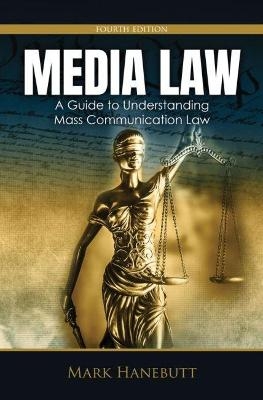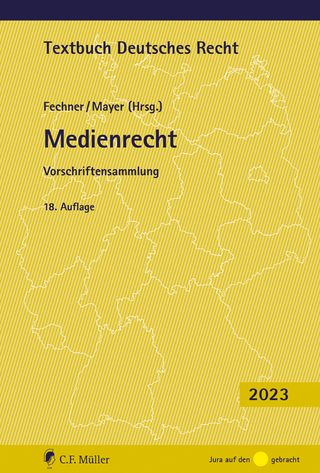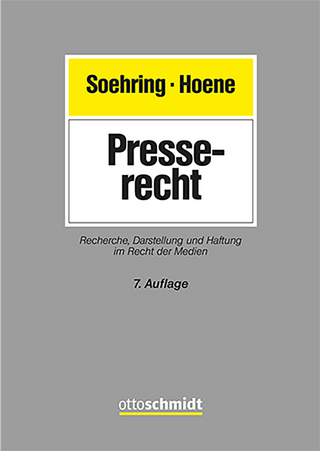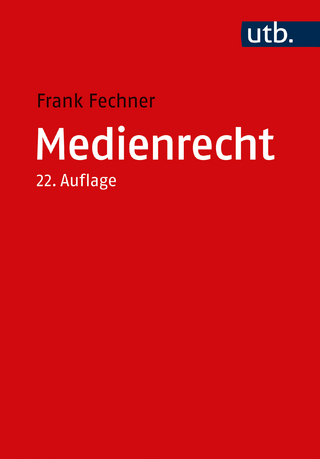
Media Law
Kendall/Hunt Publishing Co ,U.S. (Verlag)
978-1-7924-8547-3 (ISBN)
- Titel nicht im Sortiment
- Artikel merken
Media Law: A Guide to Understanding Mass Communication Law gives print journalists, broadcasters, photographers, public relations practitioners, advertisers, and those in government and the general public a basic understanding of mass communication law.
It is not meant to be a substitute for the legal training or the comprehensive legal advice that only can come from a skilled lawyer.
Available in print and eBook formats, Media Law: A Guide to Understanding Mass Communication Law:
offers students, in laymen's terms, a concise, yet complete overview of the law that affects the mass media profession.
reviews the purpose and origin of law, the foundation and basic tenets of American democracy, and an overview of the American legal system.
focuses on the First Amendment and the boundaries of free expression as defined by the U.S. Courts before examining the various specific areas of media law.
prepares students to understand enough of the law to help them know when they are facing possible legal trouble, or more importantly, to help them avoid such trouble in the first place.
Acknowledgments
Introduction
Chapter 1 The Purpose, Origin, and Types of Law
The Need for Order
Law, Ethics, and Morality
Systems of Law
Common Law
Equity Law
Statutory Law
Constitutional Law
Administrative Law
Executive Orders
Areas of Law
Chapter 2 American Democracy and the Law
Early Events That Shaped American Law
The Enlightenment—Foundation of American Government
Moving Toward a Government of, by, and for the People
Principles of Democracy
Drafting the U.S. Constitution
The Fight for Ratification
What's in the Constitution: Types and Limitations of Power
The Congress
How a Bill Becomes a Law
The Presidency
Chapter 3 The American Legal System
Seeking Truth and Interpreting the Law
A Dual Court System
The Federal Courts
The Anatomy of a Lawsuit
Civil Suits
Appeals
Criminal Trials
Finding the Law
Briefing a Case
Bench-Bar-Press Guidelines
Chapter 4 The First Amendment: A Look at Speech and Press
Protecting the Pursuit of Truth
A History of Censorship
Advocates of Free Expression
Early Suppression in America
The First Amendment: Discovering the Framers' Intent
Ways to Interpret the First Amendment Today
Absolutist Theory
Ad Hoc Balancing Theory
Preferred Position Balancing Theory
Marketplace of Ideas Theory
Access Theory
Self-Realization Theory
Meiklejohnian Theory
The Future of the First Amendment
Chapter 5 The Boundaries of Free Expression
The Alien and Sedition Acts of 1798
The Espionage and Sedition Acts of 1917 and 1918
The Clear and Present Danger Test
The Doctrine of Incorporation
More Speech, Not Less
The Smith Act of 1940
The Brandenburg Imminent and Likely Test
The Strict Scrutiny, Intermediate Scrutiny, and Rational Basis Tests
Forum Analysis
Unprotected Speech
Prior Restraint
Near v. Minnesota
Pentagon Papers
Hate Speech
Symbolic Speech
Compelled Speech
Censoring Government Employees
False Speech
Taxation as Censorship
Retaliatory Arrest
Son of Sam Laws
Grand Jury Testimony
Elections
Internet
Distributing Literature
Cake Decorating
Signs
Protests, Solicitations and Picketing
Schools
Chapter 6 Libel
The Value of Reputation
Elements of Defamation
Defamation
Identification
Publication
Damage
Falsity
Fault
The New York Times Co. v. Sullivan and Public Officials
The Impact of The New York Times Co. v. Sullivan Case
Public Figures
Limited-Purpose Public Figures
Businesses as Public Figures
Product Disparagement
Public Persons and the Passage of Time
Defenses to Libel
Truth
Summary Judgment
Statute of Limitations
Privilege
Fair Comment and Criticism
Opinion
Jurisdiction
Neutral Reportage
Wire Service Defense
Single Publication Rule
Libel-Proof Plaintiffs
Section 315 of the Federal Communications Commission Act
Consent
Right of Reply
Retractions
Chapter 7 Invasion of Privacy
The Need to Be Let Alone
Sources of Privacy Law
Contrasting Libel and Invasion of Privacy
The Growing Privacy Problem
Intrusion
Disclosure of Private Facts
Appropriation
False Light
Privacy and the Internet
Infliction of Emotional Distress
Chapter 8 Open Records and Meetings
The Need for Information
The Freedom of Information Act
Internet Access to Information
Using the Freedom of Information Act
Freedom of Information Act Exemptions
Freedom of Information Act Limitations
Interviewing Government Officials
Executive Privilege
The 1974 Privacy Act
The Buckley Amendment and Clery Act
The Federal Advisory Committee Act
Criminal History Information
The Federal Driver's Privacy Act
The Health Insurance Portability and Accountability Act (HIPAA)
Government in the Sunshine Act
State Open Records and Meetings Laws
Additional Problems of Information Access
Suggestions for Getting Information
Chapter 9 Protection of Sources
The Need to Protect Sources
Failing to Keep a Promise—When Sources Sue
Branzburg v. Hayes
Other Sources of Protection
Contempt and the Collateral Bar Rule
Criminal Cases v. Civil Cases and Nonconfidential Information
Telephone Records
Anonymous Online Posts
State Shield Laws
Who Is a Reporter?
Efforts to Pass a Federal Shield Law
Zurcher v. Stanford Daily
The Privacy Protection Act
Consider Alternatives
Chapter 10 Free Press/Fair Trial
When Constitutional Rights Collide
Sheppard v. Maxwell
Seating an Impartial Jury
Voir Dire
Change of Venue
Change of Veniremen
Continuance
Jury Admonition
Sequestration
Restrictive Orders
The Nebraska Press Association Test
Closed Courtrooms
The Press-Enterprise Test
Challenging Closure
Accessing Court Records
Electronic Records
Recording, Photographing and Televising Court Proceedings
New Technologies in the Courtroom
Bench-Bar-Press Guidelines
Eliminating Prejudicial Reporting
Chapter 11 Obscenity
Defining Sexual Expression
The Problem with Obscenity
Early Regulation of Sexual Expression
The Miller Test
Variable Obscenity
Child Pornography
Sexting
Other Ways to Regulate Obscenity
Postal Regulations
Film Censorship and Ratings Systems
Internet Filters
Withholding Government Grants
Nuisance Laws
Zoning Ordinances
Broadcast Indecency
Cable Indecency
Violence
Chapter 12 Intellectual Property
Protecting Creations of the Mind
The Copyright Act of 1790
Copyright Today
Copyright and the Internet
Copyright and Music
Duration of Copyright
Freelancers
Copyright Infringement
Unfair Competition
The Fair Use Defense
Other Defenses to Infringement
Trademarks
Duration of Trademark Protection
Marks of Distinction
Patents
Chapter 13 Advertising and Commercial Speech
The Evolution of Commercial Speech Protection
Government Regulation of Advertising
Printer's Ink Statutes
The Federal Trade Commission Act
The Commercial Speech Doctrine
Corporations and Noncommercial Speech
Media Access
The Far Reach of the Federal Trade Commission
FTC Methods to Stop False Advertising
Publicity
Substantiation
Voluntary Compliance
Consent Agreements
Litigated Orders
Corrective Advertising
Injunctions
Guides
Other Advertising Concerns
Testimonials
Mockups
Telemarketing
Internet Advertising
Comparison Ads
Bait-and-switch Advertising
Advertiser Liability and Defenses Against False-Advertising Claims
Other Federal Agencies That Regulate Advertising
The Food and Drug Administration
The Federal Communications Commission
The Securities and Exchange Commission
The Bureau of Alcohol, Tobacco, and Firearms (ATF)
The Federal Reserve Board
The Lanham Act
Self-regulation
Chapter 14 Broadcasting and the Internet
The Development of Radio
First Amendment Concerns
The Federal Communications Commission (FCC)
Licensing
The Effects of Deregulation
Broadcast Station Ownership
The Fairness Doctrine
Personal Attack Rules and Political Editorial Rules
Broadcast Ascertainment Rules
The Equal Time Rule
The Candidate Access Rule
Candidate Advertising
Children's Programming
Indecency
Violence on Television
The News, Hoaxes, and Video News Releases
Other Content Rules
Noncommercial Broadcasting
Cable Television
Direct Broadcast Satellites
Low Power Television
Satellite Radio
Low Power FM Radio
The Internet
Appendix A: The Declaration of Independence: A Transcription
Appendix B: The Constitution of the United States: A Transcription
Bibliography
About the Author
Index
| Erscheinungsdatum | 10.01.2022 |
|---|---|
| Verlagsort | Iowa |
| Sprache | englisch |
| Themenwelt | Recht / Steuern ► EU / Internationales Recht |
| Recht / Steuern ► Privatrecht / Bürgerliches Recht ► Medienrecht | |
| Wirtschaft ► Betriebswirtschaft / Management | |
| ISBN-10 | 1-7924-8547-6 / 1792485476 |
| ISBN-13 | 978-1-7924-8547-3 / 9781792485473 |
| Zustand | Neuware |
| Haben Sie eine Frage zum Produkt? |
aus dem Bereich


